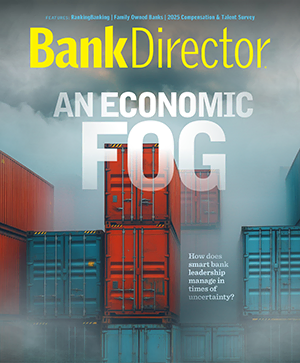
Bolstering Risk Management Through Pay Governance
Brought to you by Pay Governance LLC

Risk management has been top-of-mind for bank leaders over the past year. Even before the bank failures in March, there was increased concern among bank leaders around several areas of risk. According to Bank Director’s 2023 Risk Survey, which was released in March but conducted in January 2023, respondents’ concerns about interest rate, credit and liquidity risks all increased markedly in 2023. Bank executives and directors also identified cybersecurity and compliance as areas where their concerns have increased.
Following recent bank failures and the subsequent increased scrutiny by regulators, risk management has become the top priority of the board. As such, compensation committees are fine-tuning how their incentive plan designs and governance processes consider risk management.
Six Ways to Bolster Risk Management Through Executive Pay Governance
Boards can deploy the following safeguards to mitigate risk in their banks’ executive pay programs and signal to external stakeholders that managing risk is a priority. In addition to being effective, each practice is reasonably straightforward to implement.
1. Risk scorecard review by the compensation committee. Absent formal risk-based metrics or a discretionary incentive plan, there are limited mechanisms for the compensation committee to account for risk management performance in a typical annual incentive plan. Presumably, the risk or audit committees review key risk metrics continually. In advance of reviewing the end-of-year financial performance under the incentive plan, the compensation committee reviews the same risk metrics as a first step, either independently or jointly with the risk committee. Based on that review, they can exercise discretion to reduce the payout under the financial results if sufficient rationale exists, such as liquidity concerns or capital deficiencies, among other items.
2. Risk adjustments at the individual level. The committee can adjust earned incentives for senior executives and other key positions, like head of mortgage lending, chief credit officer or chief technology officer, based on performance against risk management priorities within their scope of influence. If a risk management rating or evaluation is part of their individual performance rating or scorecard, they can use it to influence the individual performance factor or individual performance component in the scorecard. If there is no mechanism built into the plan for individual performance, the committee can apply a last-step risk evaluation to inform any negative discretion they may apply.
3. Building more informed discretion into the incentive plan. Though proxy advisors recommend a strict formula, the absence of some discretion in an incentive plan for banks could be rife with unintended consequences. Building in a discretionary adjustment factor with predefined categories for consideration and a specific range for adjustments, such as plus or minus 15%, can align pay decisions with business and risk factors that may not be represented in preset incentive scorecard goals. This provides a mechanism for the committee to consider headwinds, tailwinds and risk behaviors when interpreting results.
4. Risk event triggers in the clawback policy. Restatement triggers will be mandatory for public companies’ clawback policy by Dec. 1. In addition to restatement, misconduct triggers are also common across the industry, while clawbacks triggered by risk events are generally only prevalent among large financial institutions. Adding a risk-event trigger for gross negligence contributing to insolvency can provide a consequential penalty for failing to prevent the worst outcomes for banks of all sizes.
5. Deferred cash. Providing a deferred cash vehicle can align executive interests with creditors and depositors and appropriately balance the shareholder alignment already provided through equity compensation. The value of deferred cash can be indexed to changes in the bank’s book value or an appropriate interest rate to preserve value against inflation; dividends can also be credited during the vesting period, just like a stock unit. The executive becomes an unsecured creditor of the bank with additional incentives to use sound judgment while driving shareholder value.
6. Audit committee confirms the pay and performance of the top audit executive. Many of the charters for the audit committees at large financial institutions task the committee with conducting the annual performance review and approving compensation for the chief audit officer. Midsize and smaller banks could add a level of transparency in their processes and reinforce the independence of the audit function by doing the same.
Managing financial risk is at the core of the industry’s value proposition. In support of this, it is essential that the board oversees programs and processes that reinforce this priority. Employing best practices in a bank’s executive pay program and governance processes can reinforce sound risk management for years to come.



